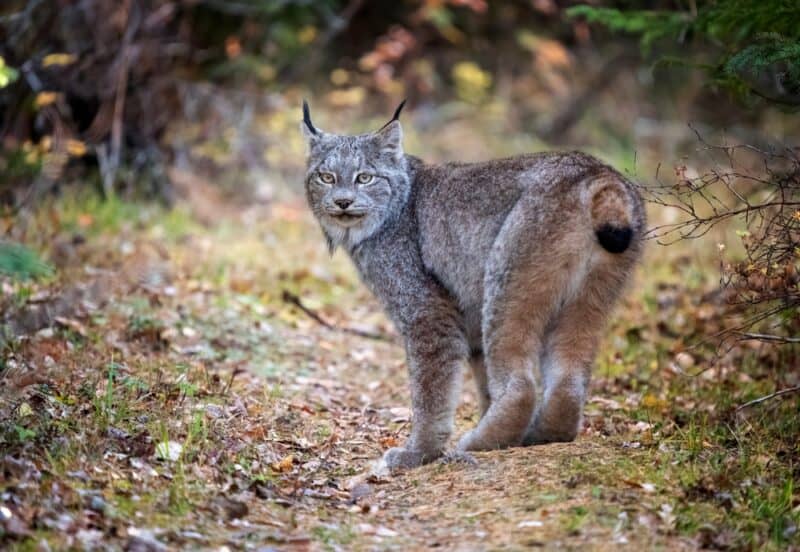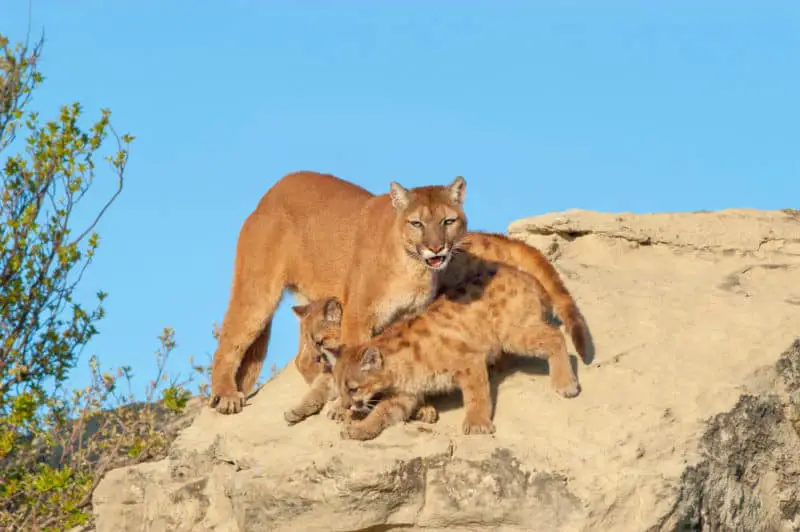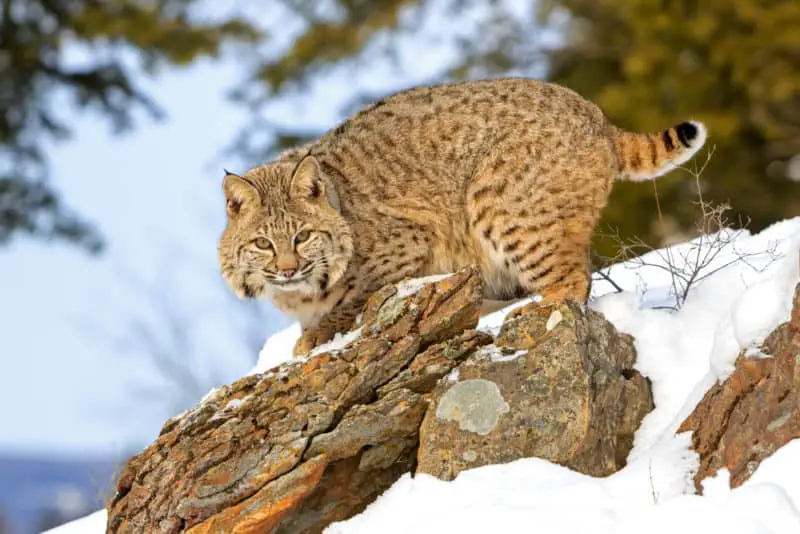Historically there were 3 different species of wild cat native to the state of New York. One of those is now extinct, while another one is currently expatriated from the state. Bobcats are the only remaining native wild felines in the empire state.
Their close relative, the Canada lynx, historically lived there but is now expatriated from the state.
Mountain lions also formerly had native range within New York. The state’s sub-species of mountain lion, the eastern cougar has not been sighted since the late 1800s and was declared extinct by the U.S. Fish and Wildlife Service in 2011. However, there is some controversy as to whether the taxonomical classification of the eastern mountain lion was correct or ever existed. See the mountain lion section below.
Bobcats in New York (Lynx rufus)
Where do Bobcats Live?
Bobcats reside only in North America. Their range begins in southern Canada and then extends south through most of the continental United States and down into central Mexico.
The New York Department of Environmental Conservation bobcat population surveys in the late 1970s determined that bobcat populations occupied roughly 13,500 square miles, which is about one-quarter of the state.
In New York, bobcats mainly reside in 3 different population centers. These are in the Adirondack region, the Catskill region, and the Taconic region. However, bobcats likely also live and breed in areas that are outside these 3 regions.
Male bobcats have larger home ranges than females do. They also travel greater distances each day. What’s more, in New York, the size of home ranges varies by region. For example, in the Adirondacks, the average home range of a male bobcat is 136 square miles, while a female uses 33 square miles. On the other hand, in home range sizes for males and females are 14 and 12 square miles, respectively. See
Below is a quote from the New York State Department of Environmental Conservation website on bobcat habitat. “The most critical features of bobcat habitat are places for refuge and protection, such as ledges. Bobcats often use rocky ledges and rock piles for shelter, breeding, and raising young. Brush piles, hollow trees, and logs are other good structures for resting and dens. Evergreen bogs and swamps-and other secluded places-also fill the bobcat’s requirement for refuge and protection.”
What do Bobcats Look Like?
Bobcats are smaller cousins to the Canada lynx
An adult bobcat is similar to the Canadian lynx in appearance with some differences.
Compared to Canadian lynx, which thrive in deep snow country, bobcats struggle more in the snow due to the fact that they cannot walk on top of it like lynx can. A lynx’s large paws function like snowshoes keeping it on the snow’s surface. They have evolved this characteristic to hunt snowshoe hares in the winter. On the other hand, compared to lynx, bobcats have smaller feet that are more proportionate to the size of their bodies. Their feet tend to sink into the snow. If the snow is too deep and powdery, it reduces their mobility along with their ability to catch prey.
A bobcat is about twice the size of a domestic cat. They are 2 to 3 feet in body length and weigh between15 to 35 pounds. Adult males are quite a bit larger than females.
These animals have a “bobbed,” short, black-tipped tail with black bands on their upper surface. The black tip on their tail is only on its upper surface but not the back. This is different than a lynx’s tail. The tip of a lynx’s tail looks as if it has been dipped in black paint. A bobcat’s tail length is between 5 and 6 inches for both sexes.
Their fur is usually gray to brown, with a fur pattern of mottled dark spots that range from black to dark brown on their bodies. They also have black stripes on their inner forelegs and tail.
From a side view, you will notice that a bobcat is slightly higher at the rump than at the shoulders. Bobcats and lynx have long hind legs in proportion to their forelegs.
Bobcats have black-tufted ears. In other words, they have short black tufts of hair that poke up above the tips of their ears. The backs of their ears, below the black tips, are black. In the center of the black of each ear, they have a single white spot. This gives the impression of a false eye on the back of each ear.
They also have a whiskered face that seems broader due to their long ruffled facial hair and whiskers. Their eyes are yellow with round black pupils.
Here is 2020 film footage of a rare black bobcat taken near Danville, Vermont. See. These melanistic bobcats have all the markings that non-melanistic ones do. They manifest as darker black spots on top of lighter black or dark grey.
What do Bobcats Eat?
Despite their comparatively small size, bobcats are aggressive, tough predators. At times, particularly during the winter, they take larger prey animals that are quite a bit bigger than they are, such as deer. In Pennsylvania, for instance, they sometimes prey on white-tailed deer.
However, their regular diets mainly consist of small mammals, reptiles, birds, and carrion. When they take up residence close to a residential area, their menu might occasionally also include small pets.
They even prey on venomous snakes when the opportunity arises despite not being immune to the venom. They accomplish this by using their quickness to pin the snake’s head down with a paw, after which they dispatch the snake with a quick bite to its spine behind the head.
What Kills Bobcats?
In New York, bobcat kittens may be prey for such animals as coyotes, foxes, owls, and fishers. Adult male bobcats also kill bobcat kittens occasionally. Adult bobcats sometimes die from injuries inflicted on them by their prey animals.
There are also twelve infectious diseases that afflict bobcats. Research suggests that these diseases may be spread to bobcats by raccoons and feral cats.
Reproduction and Life Cycle for Eastern Bobcats in New York
Bobcats in New York mate anywhere from mid-January to early February. During the breeding season, a male bobcat may mate with multiple females. Researchers have observed Radio-collared males traveling up to 20 miles in a single night to get to a female in estrus.
If they successfully mate, the gestation period for bobcats is about 60 days.
After breeding, the male and female go their separate ways. Other than in the exceptions of breeding and raising young, they’re reclusive animals.
The female takes all responsibility for the selection of a den site and the rearing of the young.
Bobcats often use rock crevices as den sites but may also den in the cavity beneath an overturned stump or beneath a blown-down tree,
In New York, bobcat litters range in size from 1 to 5 kittens.
Bobcat kittens are born with their eyes sealed, just like domestic cats are. However, their eyes will open when they are a week to 10 days old. By the time they are 2 months old, they will have replaced their spotted baby fur with a haircoat similar to what their parents have.
By mid-July, the kittens begin to venture out with their mothers to fine-tune their survival skills. Their training may last into the early winter. By mid-winter, the kittens strike out on their own.
Female bobcats reach sexual maturity at 1 year of age, while males reach sexual maturity at age 2.
In the wild, bobcats live 7 to 10 years. See

Canada lynx in New York (Lynx canadensis)
Canada lynx are a wild cat species that were also historically present in New York. However, there is presently no evidence of any breeding lynx populations within the state. What’s more, the New York Department of Environmental preservation states that they do not know for sure if self-sustaining resident populations of lynx ever existed in New York. The other alternative is that historically recorded lynx were always transient animals passing through the state.
Between 1989 and 1992, the State University of New York Environmental Sciences and Forestry dept. conducted an experiment. They released over 80 Canadian lynx which had been trapped in northwestern Canada into the Adirondacks of upstate New York. They fitted all of these animals with radio collars. Consequentially, they were able to track their movements. These lynx dispersed into places such as Pennsylvania, New Jersey, Massachusetts, New Hampshire, Quebec, Ontario, New Brunswick, and other parts of New York. What’s more, there is no evidence that any of these animals established breeding populations.
The U.S. Fish and Wildlife Service listed the Canada lynx in the contiguous United States as threatened under the federal endangered species act.
Canada Lynx Characteristics
What does a Canada lynx look like? The Canada Lynx shares a lot of physical similarities with its close relative, the bobcat. But the two also share some differences. First of all, lynx are slightly larger than bobcats. Adult lynx are up to 35 1/2 inches (90 cm) long and 26 inches (65 cm) tall. Additionally, they weigh up to 37 and a half pounds (17 kg). Lynx have stubby tails. While the tail of a bobcat is short or “bobbed,” a lynx’s tail is shorter still.
Lynx have stubby tails. While the tail of a bobcat is short or “bobbed,” a lynx’s tail is shorter still. They don’t have the black bands on the top side of their tails that bobcats have. However, they do have a completely black-tipped tail. The black tip on a lynx’s tail surrounds the entirety of the tail as if the tail had been dipped in black paint. On the other hand, a bobcat’s black tip is only on the top side of the tail.
Canada Lynx have long thick grey fur in the winter. By summertime, they have shed their grey fur and have a thinner, shorter reddish brown hair coat instead. Their color is more uniform than that of bobcats. While bobcats have black spots and mottled coloration over their entire body, Lynx are solid tan except for some mottled darker brown spots on their legs.
Canadian Lynx have triangular pointed ears with black backs and long tufts of black hair on the tips. The hair tufts are much longer than a bobcat’s. They also have drooping flared facial ruff of white hair on the sides of their face beneath their chin.
Their eyes are green with round black pupils.
Lynx have long legs in proportion to their bodies, with their hind legs being slightly longer than their front ones. This gives their body a peculiar, downhill-sloped appearance.
Canadian Lynx have evolved to prey on snow-shoe hares. They have almost comical-looking oversized fur-covered paws. They put their larger feet to good use. Their large paws function like snowshoes, allowing them to travel and hunt on top of the snow. Canadian lynx feet can keep almost twice as much weight from sinking into the snow as those of a bobcat. This is why they range over the deep snow country of northern Canada while bobcats do not.
A Lynx on Long Island?
In July of 2022, a large cat that looked a lot like a Canada lynx was on the loose for a time in the town of Central Islip. To quote Diane Huwer, who discovered the animal on her porch when she stepped outside to feed her outside cats, “It scared the daylights out of me”. When authorities eventually captured the big cat, they determined that it was a Eurasian lynx which are native only to parts of Europe and Asia. See also See

Are There Mountain Lions in New York? (Puma concolor)
According to the New York State Department of Environmental Conservation, although cougars are native to the state, and there are occasional sightings of the big cats, there is no evidence of any remnant population of resident animals.
The Mountain lion sightings that have been confirmed have either been of escaped captive animals or in one case, a cougar traveled over 1800 miles to New York from its native population in South Dakota. In other words, mountain lions are expatriated from the state. See
The last native mountain lions were removed from New York in the late 1800s. The former taxonomical classification for New York’s mountain lions was eastern cougar or eastern puma (Puma concolor couguar). This sub-species designation was proposed in 1946, and the eastern cougar has now officially been declared extinct. However, as of 2017, the Cat Classification Taskforce of the Cat Specialist Group recognizes only two subspecies of cougar as being valid. They are (Puma concolor cougar) which inhabits North America, Central America, and possibly northwestern South America, and (Puma concolor concolor) which inhabits South America See
The New York State Department of Environmental Conservation website lists mountain lions as being expatriated, not extinct.
Recent Posts
The only venomous snakes in Washington State are Northern Pacific Rattlesnakes. The Northern Pacific Rattlesnake (Crotalus oreganus oreganus) is a sub-species of the Western Rattlesnake. Anyone...
Skunks are not classified as true hibernators. But they go into a state of torpor when the weather gets cold. Skunks are light sleep hibernators, along with opossums, bears, and raccoons. ...

